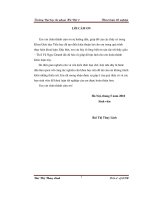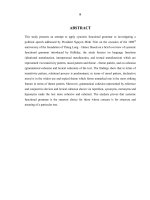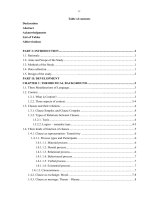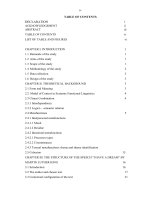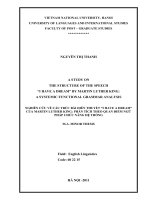nominalization in legal discourse a systemic functional analysis = danh hóa trong văn bản luật pháp phân tích theo quan điểm chức năng hệ thống
Bạn đang xem bản rút gọn của tài liệu. Xem và tải ngay bản đầy đủ của tài liệu tại đây (2.84 MB, 98 trang )
i
HANOI NATIONAL UNIVERSITY
UNIVERSITY OF LANGUAGES AND INTERNATIONAL STUDIES
POST GRADUATE DEPARTMENT
*****
NGUYỄN THỊ HUYÊN
NOMINALIZATION IN LEGAL DISCOURSE:
A SYSTEMIC FUNCTIONAL ANALYSIS
DANH HÓA TRONG VĂN BẢN LUẬT PHÁP:
PHÂN TÍCH THEO QUAN ĐIỂM CHỨC NĂNG HỆ THỐNG
M.A THESIS
English Linguistics
60 22 15
HANOI – 2011
ii
HANOI NATIONAL UNIVERSITY
UNIVERSITY OF LANGUAGES AND INTERNATIONAL STUDIES
POST GRADUATE DEPARTMENT
*****
NGUYỄN THỊ HUYÊN
NOMINALIZATION IN LEGAL DISCOURSE:
A SYSTEMIC FUNCTIONAL ANALYSIS
DANH HÓA TRONG VĂN BẢN LUẬT PHÁP:
PHÂN TÍCH THEO QUAN ĐIỂM CHỨC NĂNG HỆ THỐNG
M.A. THESIS
Major: English Linguistics
Code: 60 22 15
Supervisor: Prof. Dr. HOÀNG VĂN VÂN
HA NOI - 2011
iv
TABLE OF CONTENTS
DECLARATION i
ACKNOWLEGMENT ii
ABSTRACT iii
TABLE OF CONTENTS iv
LIST OF ABBREVIATIONS vii
LIST OF FIGURES AND TABLES …viii
PART A: INTRODUCTION 1
1. Rationale 1
2. Significance of the study 1
3. Aims of the study 2
4. Scope of the study 2
5. Method of study 2
6. Design of the study 3
PART B: DEVELOPMENT 4
CHAPTER 1: THEORITICAL BACKGROUND 4
1.1. Introduction 4
1.2. An overview of grammatical metaphor theory 4
1.2.1. Definitions of grammatical metaphor 4
1.2.2. Classification of grammatical metaphor 5
1.2.2.1. Ideational metaphor 6
1.2.2.2. Interpersonal metaphor 7
1.2.2.2.1. Metaphors of modality 7
1.2.2.2.2. Metaphors of mood 8
1.3. Concluding remarks 10
CHAPTER 2: NOMINALIZATION 11
2.1 Introduction 11
2.2 What is nominalization? 11
2.3 Functions of nominalization 12
2.4. Categories of nominalization 14
v
2.4.1. Lexical nominalization 14
2.4.1.1. Derivational nominalization 14
2.4.1.1.1. Deverbal nominalization 14
2.4.1.1.2. Deadjectival nominalization 15
2.4.1.2. Zero derivational nominalization (conversion) 16
2.4.2. Clausal nominalization 16
2.4.2.1. That-clauses 17
2.4.2.2. Wh-clauses 19
2.4.2.3. To-clauses 20
2.4.2.4. Ing-clauses 23
2.5. Concluding remarks 24
CHAPTER 3: REALIZATION OF NOMINALIZATION IN ENGLISH legal
discourse: “Convention On The Rights Of The Child” 25
3.1. Introduction 25
3.2. English Legal discourse 25
3.2.1. Classification of English legal discourse 25
3.2.2. Characteristics of English legal language 25
3.2.2.1. Lexical characteristics 26
3.2.2.2. Grammatical characteristics 27
3.2.2.3. Textual characteristics 29
3.3. Realization of nominalization in prescriptive legal text “Convention on the Rights of
the Child” 30
3.3.1. Introduction 30
3.3.2. Frequency of nominalization 30
3.3.3. Typical types and characteristics of nominalization 31
3.3.3.1. Typical types of nominalization 31
3.3.3.2. Some typical characteristics of nominalization 34
3.3.4. Semantic role of nominalization realized in terms of ideational, interpersonal
and textual metafunctions 35
3.3.4.1. In terms of ideational metafunction 35
3.3.4.2. In terms of interpersonal metafunction 38
vi
3.3.4.3. In terms of textual metafunction 38
3.4. Concluding remarks 41
PART C: CONCLUSION AND IMPLICATIONS 42
1. Recapitulation 42
2. Implications for teaching and translating English legal discourses 43
2.1. To teachers and students: 43
2.2. To translators 43
3. Limitation and suggestions for further studies 43
REFERENCES 45
APPENDIX A
APPENDIX B
vii
LIST OF ABBREVIATIONS
ESP: English for special purposes
SFG: Systemic functional grammar
T: Theme
R: Rheme
NP: Noun phrase
CONV: Conversation
FICT: Fiction
ACAD: Academic
DV: Deverbal nominalization
DA: Deadjectival nominalization
TH: That- clause
TO: To- clause
WH: Wh- clause
ING: Ing- clause
viii
LIST OF FIGURES AND TABLES
Figure 1a: Analysis of congruent form page 6
Figure 1b: Analysis of metaphorical form page 7
Table 1.1: Modality system page 8
Table 2.1: Converted nouns page 16
Table 2.2: Types of to-clause complements across registers page 22
Table 3.1: Frequency of occurrence of nominalization page 30
Table 3.2: Type of nominalization page 31
Table 3.3: Ideational realization of nominalization page 36
Table 3.4: Interpersonal realization of nominalization page 38
Table 3.5: Textual realization of nominalization page page 39
1
PART A: INTRODUCTION
1. Rationale
Nominalization is one of the most prominent features of formal written discourses.
According to Fowler (1991:79), “English is a sort of nominalized language” so
nominalization characterizes almost all English written texts and its frequency of
occurrence varies in different functional varieties, especially those formal functional
varieties. As one type of very formal written discourse, English legal discourse is noted for
its high frequency of nominalization. Apart from the roles of nominalization in
constructing the specific characteristics for this genre, nominalization is also one of the
grammar structures causing a higher degree of ambiguity in legal discourses. When
nominalizing, semantic information is usually left out, which increases the degree of
ambiguity and the difficulty in correctly decoding the sentence. Therefore, understanding
the nature and characteristics as well as the roles of nominalization in English legal
discourse will make great contribution to the perception of this discourse genre, which is
very necessary in today‟s world when globalization and integration has become an
inevitable trend. Thus, it is of great necessity to conduct a study on the phenomenon of
nominalization in legal discourses if we want to learn more about this important variety of
English and benefit the reading and writing of English legal discourses as well as help
translators much easier in translating Vietnamese legal discourses into English and vice
versa.
Using the theory of systemic functional grammar which is considered a satisfactory
explanation of the phenomenon of nominalization as developed by Halliday (1994) and
some other systemic linguists, this thesis attempts to explore how nominalization is
realized in English legal discourse with the hope that it will help readers to recognize the
importance of nominalization for the comprehension and manipulation this specific genre.
2. Significance of the study
The result of this study may help improve the ability of understanding English legal
discourses and limit avoidable misunderstandings in interpreting legal discourses. It also
makes contribution to the teaching and learning of ESP for English teachers and students
2
majoring in law. Besides, this thesis hopes to assist the translation of Vietnamese legal
discourses into English and vice versa.
3. Aims of the study
The aim of the study is to make an inquiry into how nominalization is realized in English
legal discourse. To achieve this aim, the study will examine the nature of nominalization,
its functions as well as its types. Besides, the main characteristics of English legal
discourse will be pointed out to set the base for finding out the typical realization of
nominalization in this legal discourse.
Thus, to achieve the aim of the study, the main research question needs to be raised for
exploration is:
How is nominalization realized in English legal discourse?
However, to find the answer for this main question, two following questions must be
investigated first:
1. What is nominalization?
2. What are the main characteristics of English legal discourse?
4. Scope of the study
The scope of this study is just to investigate the typical realization of nominalization in
English legal discourse. Since this genre consists of various subtypes, within the limited
space for a minor thesis, I only explore the use of nominalization in one of genre in English
legal discourse - prescriptive legal text. In this thesis, the legal text “Convention on the
Rights of the Child” (1989) was chosen as data for my study.
5. Method of study
This is a case study which sets its main objective of investigating how nominalization is
realized in English legal discourse using systemic functional grammar as the theoretical
framework.
To achieve the goal of the study, both quantitative and qualitative method will be
employed. These two methods are complimentary with the quantitative approach being
3
used to collect and categorize data and the qualitative one to interpret the statistics taken
from the data.
6. Design of the study
The study consists of three chapters:
Chapter 1 provides the theoretical background of the study. This chapter focuses on
introducing important concepts in systemic – functional linguistics relevant to the topic of
the thesis such as definitions of grammatical metaphor and its classifications.
Chapter 2 investigates the general notion of nominalization in the light of the systemic
functional theory and some other linguistic approaches. In this chapter, nominalization‟s
definitions, functions and classification will be presented.
Chapter 3 provides the background knowledge of English legal discourse by giving its
definition, classification and main characteristics. Then, an attempt is made to find out how
nominalization is realized in English legal discourse. In this part, the frequency of
occurrence of nominalization, its typical types, characteristics and semantic roles seen
from ideational, interpersonal and textual metafunctions will be investigated.
4
PART B: DEVELOPMENT
CHAPTER 1
THEORITICAL BACKGROUND
1.1. Introduction
Grammatical metaphor is one of the most interesting theoretical notions developed by
Halliday (1985/1994) and some other systemic linguists such as Thompson (1996), Martin
(1985), etc. In this chapter, the first focus is to examine the concept of grammatical
metaphor in systemic functional linguistics. We will start by providing the definitions of
grammatical metaphor. Then, different views on the classification of grammatical
metaphor are also presented.
1.2. An overview of grammatical metaphor theory
1.2.1. Definitions of grammatical metaphor
The concept of grammatical metaphor arose from the ancient time by the Ancient Greek
philosopher - Aristotle. For him, metaphor was defined as “one word for a concept used to
refer to another one”. Therefore, metaphor involves a transference. His theory of metaphor
puts the primitive foundation for the concept of grammatical metaphor which has been
developed by modern linguistists two thousand years later.
The concept of grammatical metaphor was then introduced in Halliday‟s An introduction to
Functional Grammar (1985/1994). In this book, Halliday revised and improved his
Functional Grammar constantly, and put forward the concept of grammatical metaphor.
Halliday took a new approach which is different from the traditional one, looking metaphor
“from above” as “variation in the expression of a given meaning” not “from below” as
“variation in the meaning of a given expression” of the traditional approach. For him,
metaphor is also a transference, which uses a kind of grammar means to replace another,
but expresses the same grammatical meaning. From this point, grammatical metaphor has
its unique performance characteristics as a kind of grammar phenomenon. The congruence
and metaphor are two means to express the meaning, both of which have difference in the
event of the order, frequency, and cognitive habit.
5
According to Halliday and Martin (1993: 79) cited in Wang (2002), a grammatical
metaphor (GM) is a substitution of one grammatical class, or one grammatical structure, by
another; for example, “his departure instead of he departed”. Put it simply, the process of
depart has been turned into a noun.
Another systemic linguist who is also concerned about the concept of grammatical
metaphor is Thompson. In his book – Introducing functional grammar (1996: 165), he
defined grammatical metaphor as the expression of a meaning through a lexical-
grammatical form which originally evolved to express a different kind of meaning. The
expression of the meaning is metaphorical in relation to a different way of expressing the
„same‟ meaning which would be more congruent. Consider the following examples:
[1:1] (i). Water evaporates from a puddle.
(ii). Evaporation occurs more quickly in hot weather.
(ii) is grammatical metaphor because in this sentence a process evaporates is rendered in a
nominal type Evaporation.
1.2.2. Classification of grammatical metaphor
Systemic linguists often pay attention to the function of grammatical metaphor when
classifying different types of grammatical metaphor. According to Halliday, language has
three metafunctions involved in one clause: ideational function, interpersonal function, and
textual function. Language is used to organize, understand and express our perception of
the world by the ideational function, which can be divided into experiential function and
logical function. The experiential function is mainly associated with the ideas, while the
logical is concerned with the relationship between ideas. People use language to
communicate with other people, to express their feelings and attitude by interpersonal
function. On the basis of these metafunctions, Halliday (1994: 343) classifies grammatical
metaphor into two main types: metaphors of mood (including modality) and metaphors of
transitivity. In terms of model of semantic functions, these are, respectively, interpersonal
metaphors and ideational metaphor.
When classifying grammatical metaphor, Martin (1992) seems more detailed. He divided it
into ideational (logical and experiential), interpersonal and textual metaphor.
6
Meanwhile, H.V.Van (1999) shows that an instance of grammatical metaphor may be
involved in more than one metafunction. This means that a congruent realization in the
interpersonal metafunction may have its metaphorical realization in the experiential
metafunction. For example,
[1:2] (i) She should go to the meeting.
(ii) Her obligation is to go to the meeting.
In the two above examples, “should” is a congruent realization in the interpersonal
metafunction and “obligation” is a metaphorical realization in the experiential
metafunction.
In the following sections, we will adopt Halliday‟s view in classifying grammatical
metaphors into ideational metaphor and interpersonal metaphor.
1.2.2.1. Ideational metaphor (metaphor of transitivity)
Ideational metaphors are usually expressed through the transitivity system (material,
ralational, behavioral, mental, verbal, and existential). According to Halliday (1994: 343),
there are three steps involving in the process of choices in the transitivity system of
language. First is the selection of process type (material, mental, relational). Second is the
configuration of transitivity functions (Actor, goal, senser, manner…). Third is the
sequence of group – phrase classes (verbal group, nominal group, adverbial group,
prepositional phrase, and their various sub-classes). Variation in any of the selection can
lead to ideational grammatical metaphor. Let look at the following examples:
[1:3] (i) They arrived at the summit on the fifth day.
(ii) The fifth day saw them at the summit.
(i) and (ii) can be represented diagrammatically in two following figures:
Figure 1a: Analysis of congruent form
They
arrived
at the summit
on the fifth day
Actor
Material
Place
Time
(Source: Halliday (1994: 346)
7
Figure 1b: Analysis of metaphorical form
The fifth day
saw
them
at the summit
Senser
Mental perception
Phenomenon
Place
(Source: Halliday (1994: 346)
From the comparison of the two sentences above, “the fifth day” in sentence (i) is the
expression of time, which meets the reality and is the congruence. But “the fifth day” in the
sentence (ii) becomes the feeler of a thinking process and the material process has become
the process of psychology, so sentence (ii) is called the metaphor.
Ideational metaphor is a powerful resource in the grammar of a language, by which the
expression of ideational meanings such as processes, qualities and entities is extended in
important ways beyond their default encodings as clauses, adjectives and nouns (or noun
phrases) respectively: different forms can be borrowed to express different meanings.
Important work on ideational metaphor in systemic functional framework concerns the
study of which particular forms can be used to express which particular meanings. In this
context, Halliday has proposed a model showing that certain forms (especially noun
phrases) are more likely to be used as metaphorical forms than any other types of
expressions
1.2.2.2. Interpersonal metaphor
As we have seen above, the interpersonal component of grammar especially concerns the
areas of MODALITY and MOOD. In these two areas, Halliday (1994) also distinguishes
between basic, non-metaphorical expressions, and metaphorical ones, i.e. interpersonal
metaphors. Let us look at each area in turn.
1.2.2.2.1 Metaphors of modality
According to Halliday (1994), the first type of interpersonal metaphor is the metaphor of
modality. Modality is used to express the speaker‟s opinion of thing. There are four
variable in modality, which are TYPE, ORIENTATION, VALUE and POLARITY.
Modality refers to the area of meaning that lies between yes and no – the intermediate
ground between positive and negative polarity. What this implies more specifically will
depend on the underlying speech function of the clause. If the clause is an “information”
8
clause, it is modalization. If the clause is a “goods - & - service” clause, it is called
modulation. Each type contains two degrees: Modalization has degree of probability and
modulation has degree of obligation or of inclination. However, the orientation is the factor
that determines how each type of modality will be realized. Thus, they should be
distinguished between subjective and objective modality; between explicit and implicit
variants. The third variable in modality is the value that is attached to the modal judgment:
high, median or low. The median value is clearly set apart from the two “outer” values by
the system of polarity: the median is that in which the negative is freely transferable
between the proposition and the modality. (Eg: Direct negative: It‟s likely Mary doesn‟t
know Transferred negative: It isn‟t likely Mary knows). With the outer values, if the
negative is transferred the value switches (Eg: Direct negative: It‟s certain Mary doesn‟t
know (high) It isn‟t possible Mary knows (low)).
A network of modality systems is set up as in table 1.1 below:
TYPE
modalization
probability
usuality
modulation
obligation
inclination
ORIENTATION
subjective
objective
explicit
implicit
VALUE
median
outer
high
low
POLARITY
positive
negative
direct
transferred
Table 1.1: Modality system
(Source: Halliday, 1994: 360)
9
1.2.2.2.2. Metaphors of mood
The second interpersonal area in grammar, according to systemic functional linguistics, is
that of mood. In order to understand the notion of interpersonal metaphors of mood, it is
necessary to consider, again, what the default types of encoding are. According to Halliday
(1994: 363), mood expresses the speech functions of statement, question, offer and
command. Statements are expressions which give information, questions are expressions
which ask information, offers are the expressions which put forward something to be
considered and accepted or refused and commands are expressions which ask for
something to take place. Each of these functions has its standard, default type of encoding:
statements are encoded by the declarative, questions by the interrogative, and commands
by the imperative clauses. The expression of statements and questions is fairly
straightforward, but with regard to commands, the situation is different. There is a large
variety of expressions that can be used to express the same command:
[1:6] Send your proposal by email, please.
[1:7] (i) Could you send your proposal by email, please?
(ii) I would advise you to send it by email.
(iii) You are kindly requested to send your proposal by email.
(iv) It is recommended that you send your proposal by email.
(v) It is advisable to send your proposal by email.
The examples in [1:7] are different metaphorical variants of expressing a command that
can also be expressed, in its most straightforward, standard way, as an imperative [1:6].
The metaphorical examples in [1:7] include the interrogative mood type (which is the
standard expression of requests for information), and the declarative mood type (which
normally, i.e. non-metaphorically, expresses the speech function of giving information).
Halliday brings together these various expressions under the heading of the notion of
interpersonal metaphor of mood. The reason why these examples are regarded as
metaphorical, lies in the fact that they deviate from the standard, most straightforward
realization of a command by means of the imperative mood. Their metaphorical nature can
be made clear by pointing to the literal meanings that these expressions have. For instance,
(i), at face-value, is basically a request for information: „could you send your proposal by
10
email, or couldn‟t you‟? Similarly, at face-value, (ii) only refers to a statement: I state that
I advise something to you.
The metaphorical nature of such metaphors of mood is exploited in verbal play. A case in
point is the well-known dinner-table example, where someone asks: Can you pass me the
salt, please? and the addressee answers, „Yes, I could certainly do that‟, without
undertaking any further action with regard to the salt.
1.3. Concluding remarks
This chapter has been concerned with the examination of grammatical metaphor in the
framework of the systemic-functional model. Its major points may be summarized as
follows:
- Grammatical metaphor is a substitution of one grammatical class, or one grammatical
structure, by another (Halliday and Martin, 1993: 79) or as the expression of a meaning
through a lexical-grammatical form which originally evolved to express a different kind of
meaning (Thompson, 1996: 165).
- Different systemic linguists have different views on grammatical metaphor. It can be
classified into logical, experiential, interpersonal and textual metaphor by Martin or
ideational and interpersonal metaphor by Halliday (1994).
In the following chapter, the nature of nominalization along with its functions and types
will be presented to set the background knowledge for understanding its realization in legal
discourse.
11
CHAPTER 2
NOMINALIZATION
2.1. Introduction
Nominalization is a prevalent linguistic phenomenon in English, especially in written
English so that this phenomenon has been investigated by many linguists. In this chapter,
different points of views toward the definitions of nominalization will be presented. Then,
a substantial part will be devoted to the exploration of the functions and classification of
nominalization into different categories
2.2. What is nominalization?
The phenomenon of nominalization has been studied by many researchers. Scholars from
different linguistic schools present different points of view toward nominalization.
Therefore, there are different definitions of nominalization in English.
According to Quirk (Quirk et al. 1985), nominalization is a process of turning a verb or an
adjective into a noun. In a somewhat similar manner, nominalization is defined as the
grammatical process of forming nouns from other parts of speech, usually verbs or
adjectives (Longman Dictionary of Language Teaching and Applied Linguistics, 2002) or
as any process by which either a noun or a syntactic unit functioning as a noun phrase is
derived from any other kind of unit such as a verb or an adjective (Oxford Dictionary of
Linguistics).
The common idea among these definitions is that all the definitions above are concerned
about the changes of the lexical elements but the function and structures of nominalization
in a clause. Quirk et al. (1985) refer to a narrow sense of nominalization and it only
involves the change of form and grammatical categories.
Having a broader view, Chomsky (1968) believes that “nominalization is a process by
which a stem, verb phrase or sentence is transformed into a nominal”. According to him,
nominalization is not only the changes in terms of lexical elements but, more broadly, the
changes in terms of sentence also.
Compared with other approaches, systemic functional linguists make a more thorough and
profound analysis of nominalization. Thompson (1996: 167) argues that “nominalization is
12
the use of a nominal form to express a process meaning”. He adds that “nominalization can
also be used to express an attributive meaning – a relational process together with the
Attribute”. To Mathews (1997), nominalization is “any process by which either a noun or a
syntactic unit functioning as a noun phrase is derived from any other kind of unit”. As one
of the most famous systemic linguists, Halliday (1985) points out that nominalization
refers to any element or group that can function as nouns or noun groups in a clause,
including clauses, nominalized adjectives or verbs, etc. He emphasizes that nominalization
is the single most powerful resource for creating grammatical metaphor. By this device,
processes (congruently worded as verbs) and properties (congruently worded as adjectives)
are reworded metaphorically as nouns; instead of functioning in the clause, as Process or
Attribute, they function as Thing in the nominal group. In Halliday‟s definition, he focuses
on the “function” of the elements in clause and provides a unique standpoint on
nominalization as a meaning-making resource. According to Dik (1997: 159), we
understand that nominalization is an embedded construction which has one or more
properties in common with a primary, nominal term. This means that any elements that
have one or more characteristics in common with nominal term can be considered as
nominalization.
As the main emphasis of each study is different, researchers have different opinions about
nominalization. But each definition has its own value and something in common – that is
the drift toward “thingness. From definitions above, some functions of nominalization can
be pointed out as follows:
2.3. Functions of nominalization
- Nominalization is a powerful resource for making meaning in scientific and technical
register, where it plays a dual role. First, a noun typically refers to a “thing”, i.e. something
which exists. By “nouning” a process, the writer can reflect a fact that he has negotiated
and established the meaning of the clause centred around the process – in other words, that
meaning can now be treated as existing, as a kind of abstract “thing”. Second, it makes it
possible to develop an argument step by step, using complex passages “packaged” in
nominal form as Theme. This important function of nominalization is encapsulation
(Thompson, 1996: 170)
13
- Nominalization helps create the sense of objectivity for the text. The reason why
nominalization is in harmony with the ideology of academic, formal writing in general, is
that it allows processes to be objectified, to be expressed without the human doer.
Nominalization is used for ideological control as a “masking device” for they allow the
withholding of the identity of the actors. It not only obscures the participants, it also
obscures the time, space and modality. Thompson (1996: 171) points out that nominalized
processes are non-finite: they are not tied to any specific time in relation to the time of
speaking. (Incidently, this is yet another reflection of the functional unity of Mood: both
Subject and Finite typically disappear when a process is nominalized). Thus a nominalized
process is detached from the here and now in a way that is not normally possible for a
process expressed by a verb. Thus by using nominalization, writer can obscure not only the
participants but also the time, the space, and the modality to make the expression more
objective and non-negotiable.
- Nominalization can add another semantic dimension to what already exists in the
congruent form. According to Halliday (1994: 353), the piece of wording that is
metaphorical has as it were an additional dimension of meaning: it means both
metaphorically and congruently.
- The use of nominalization has changed people's perception of the world, or the world of
experiences. Nominalization is a tool used to name things in certain forms in different
ways, as though the identities have been transformed into different things. Actually, this
occurs when human beings begin to vision the situation from a new perspective, a
metaphorical one. The use of nominalization is a great progress made in the cognitive
capability of human beings.
- Nominalization makes the text more ambiguous. In a text packed with nominalizations,
when clausal patterns or congruent forms are replaced by nominalized ones, some of the
information is lost. The writer presumably knows exactly what they mean; but the reader
may not so this kind of highly metaphorical discourse tends to mark off the expert from
those who are uninitiated (Halliday, 1994: 353). Therefore, it makes the text more formal
with a touch of ambiguity.




